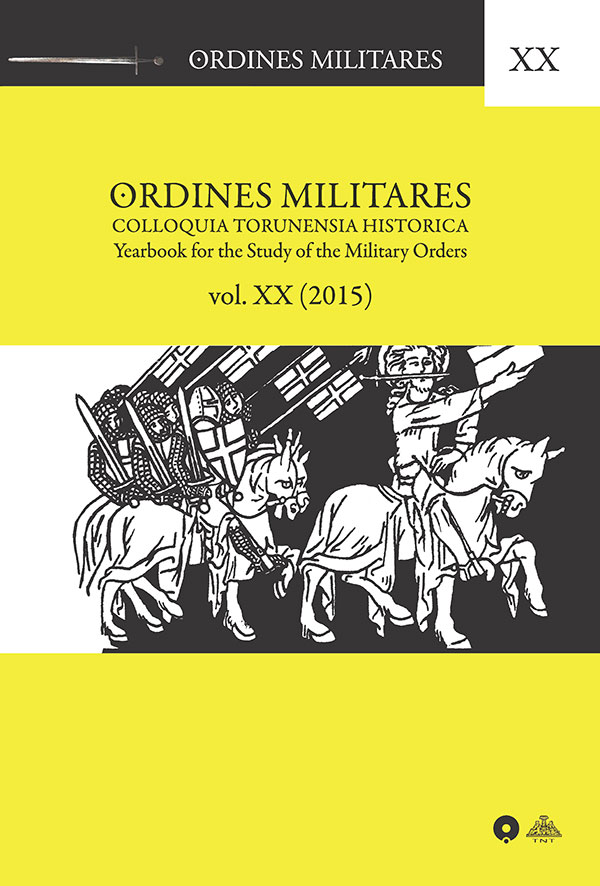The knight brothers from the Low Countries in the conflict between the Westphalians and the Rhinelanders in the Livonian branch of the Teutonic Order
DOI:
https://doi.org/10.12775/OM.2015.006Keywords
Teutonic Order, Livonia, internal conflicts, 15th century, medieval prosopography, careersAbstract
In the fifteenth century the Livonian branch of the Teutonic Order was internally divided by a long-lasting conflict between two groups of knight brethren, the Westphalians and the Rhinelanders, who were united according to regional origin. They each strived to control the most important offices, though their discord indirectly also concerned the political course of the Order state. The central question in this paper is how the brethren from the Netherlands – not clearly being tied to Westphalia or the Rhineland - fared in this strife for predominance within Livonia. It is shown that the brethren from the Low Countries got access to central positions by joining the Rhineland group, who - with support of Grand Master Paul von Rusdorf in Prussia – gained the upper hand for some time, especially after one of them, Cisse van den Rutenberg, was appointed Livonian Master in 1424 The result was that the ‘Dutch’ could increase their number, counting for about one sixth of the Livonian knights around 1435. Looking more closely at the background of the Rhinelanders we have to conclude that these, originating from regions at relatively great distance from each other, did not constitute a cohesive party but must have made up a broad non-Westphalian rest category. The members might have tended to seek each other’s help against exclusion by a Westphalian core group. When the Westphalians succeeded in regaining the leading position in 1438, they reinforced their grip on the recruitment and advancement of the knight brethren. For the ‘Dutch’, this meant that they lost all career perspectives, with the result that their number decreased greatly after 1450.
References
van Doorninck Jan I., edit. Tijdrekenkundig register op het oud provinciaal archief van Overijssel, 1225-1496, aanhangsel. Zwolle: De Erven Tijl, 1874.
de Geer tot Oudegein, Jan J., edit. Archieven der Ridderlijke Duitsche Orde, balie van Utrecht. 2 vols. Utrecht: Kemink en zoon, 1871.
Hildebrand, Hermann., edit. Liv-, Est- und Kurlandisches Urkundenbuch [I. afd.]. vol. VIII: 1429 Mai - 1435. Riga, Moskau: Heinrich Laakmann, 1885 (reprint: Aalen: Scientia Verlag, 1974)
Joachim, Ernst. Hubatsch, Walter., edit. Regesta Historico-Diplomatica Ordinis S. Mariae Theutonicorum 1198-1525. vols. 1-2. Göttingen: Vandenhoeck & Ruprecht, 1948-1973.
Benninghoven, Friedrich. “Die Burgen als Grundpfeiler des spätmittelalterlichen Wehrwesens im preußisch livländischen Deutschordensstaat.” In Die Burgen im Deutschen Sprachraum (part 1), edited by Hans Patze, 565-601. Sigmaringen 1976.
Benninghoven, Friedrich. “Zur Zahl und Standortverteilung der Brüder des Deutschen Ordens in den Balleien um 1400.” Preußenland 26 (1988): 1-20
Christiansen, Eric. The Northern Crusades. The Baltic and the Catholic frontier 1100-1525. London: The Macmillan Press, 1980.
Jähnig, Bernhart. Verfassung und Verwaltung des Deutschen Ordens und seiner Herrschaft in Livland. Berlin: LIT-Verlag, 2011.
Lückerath, Carl A. Paul von Rusdorf. Hochmeister des Deutschen Ordens. Bonn, Bad Godesberg: Verlag Wissenschaftliches Archiv, 1969.
Merckens, Otto. “Die Vorfahren der Irmgard von Schönau (Schoenauwen), Gemahlin des Johann Schenck von Nydeggen.” Jülich-Bergische Geschichtsblätter 11 (1934): 17-22, 43-48.
Militzer, Klaus. “Die Ritterbrüder im livländischen Zweig des Deutschen Ordens. Eine Einführung in die Möglichkeiten und Grenzen der Auswertung des Ritterbruderkatalogs.” In Ritterbrüder im livländischen Zweig des Deutschen Ordens, edited by L. Fenske, K. Militzer, 11-70. Köln, Weimar, Wien: Böhlau, 1993.
Neitmann, Sonja. Von der Grafschaft Mark nach Livland. Ritterbrüder aus Westfalen im livländischen Deutschen Orden. Köln, Weimar, Wien: Böhlau, 1993.
Ritterbrüder im livländischen Zweig des Deutschen Ordens, edited by L. Fenske, K. Militzer. Köln, Weimar, Wien: Böhlau, 1993.
Van Schilfgaarde, Anthonie P. “Het adellijk geslacht Van Rossem.” De Nederlandsche Leeuw 70 (1953): 134-149.
Stapel, Rombert. ““Onder dese ridderen zijn oec papen”. Priesterbroeders in de balije Utrecht van de Duitse Orde (1350-1600).” Jaarboek voor Middeleeuwse Geschiedenis 11 (2008): 205-248.
Downloads
Published
How to Cite
Issue
Section
License
CC BY ND 4.0. The Creator/Contributor is the Licensor, who grants the Licensee a non-exclusive license to use the Work on the fields indicated in the License Agreement.
Stats
Number of views and downloads: 847
Number of citations: 0



